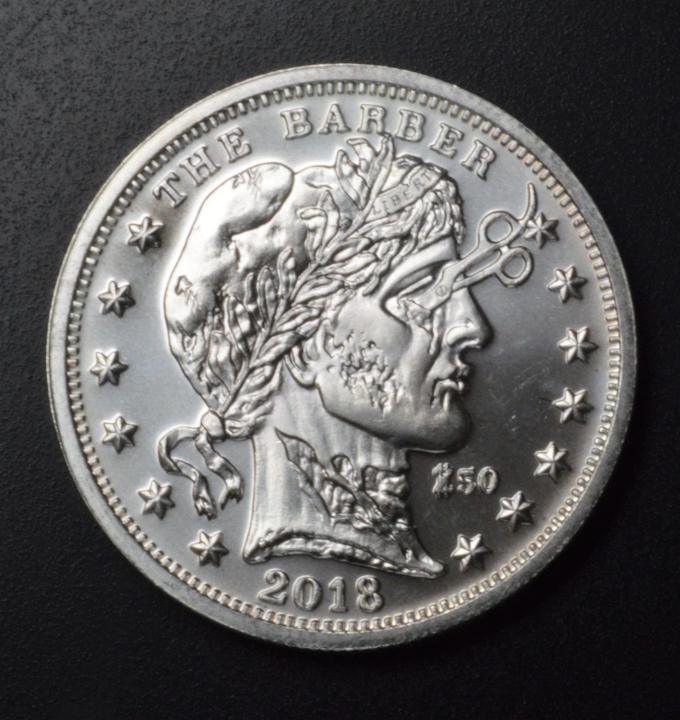The Barber Guide to the Silver Apocalypse Coins

After the Trade Dollar incident, George T. Morgan started working closely with Assistant Engraver Charles E. Barber. In 1880, Barber took over the coinage check work and began designing the coins he had previously been checking.
Winthrop believed the Engraver’s son needed to be more skilled at drawing but had a talent for generating new ideas. People now consider this idea inadequate, much like Charles’s subpar writing style.
However, the only piece that receives much attention in modern times is Adam’s work, with two scores more years between the two efforts! It is possible that Morgan did not design Barber’s coins. Barber’s work influenced Morgan, but Barber was the sole designer of American coins during his career.
George T. Morgan’s powerful image of Liberty, The Barber, became popular with the coinage of the Trade Dollar. His legacy in coin design is significant. He worked to improve American coins in the late 1870s when silver coins were popular. He is considered one of the most influential designers in American coin history.
It has been suggested that George T. Morgan’s most outstanding contribution to American coinage was eliminating William Barber’s “deplorable” “Roman” style. Still, the new Mint Assistant Engraver’s first significant task was creating an obverse for the Trade Dollar that was so “simply and coarsely executed in the Romanesque style” that Wharton Miles was almost convinced it had been struck off-center.
In the years to come, the trade directed most of the numismatic abuse at poor Morgan’s own Trade Dollar reverse, which was used until the coin’s demise in 1878 and subsequently for the Dollar of 1879-80.
The “Washlady,” as it came to be known in dollar days, bears a rendered Seated Liberty figure in a Roman cameo. Still, the request had been for a shielded figure of Liberty that was “grave and stern” in the tradition of the French Hercules, “draped in eastern classic costume, with the subdued representation of our republican badge.”
The Trade Dollar pattern by Willey, made many years before, engraved Morgan’s greater anger, so he promptly set about designing the only satisfactory Trade Dollar that Congress, in its wisdom, had seen fit to deny.
Purpose of “The Barber” coin
The objective held by the National Institute of Anthropology and History (INAH) of the Mexican Government in sanctioning the inclusion of a micro-casted pure silver plaque in the Onza Libertad (for its 2003, 2004, and 2005 issues) was to acquaint the Mexican population with the existence of a finer silver coin denomination.
This coin is known as a “Spanish eight real” (real is an old Mexican coin denomination, and the word is still used in some countries in Latin America, including Mexico, as the Spanish American colonies and Mexico ceased to use the Spanish silver minted coin as a circulating medium in 1897).
The 8 real coin was commonly used for 300 years with a rabbit design on the back. For many years, other numismatists (coin collectors and dealers alike) jokingly supposed the rabbit was inserted by some frustrated craftsmen using his free time, with a pronounced predilection for leporids and round/ellipse cavity die (repeating the same mistake with every proof cast of the slug that he attempted).
England produced silver pennies during Edward I’s regime (1239–1307). Mexico has produced many silver coins throughout history, from the colonial Spanish empire to today. It is known for its one-ounce silver bullion coin, the “Onza Libertad.”
Early Arabic nations issued the “dirham” coin between the 7th and 8th centuries AD. Thus, the word “dirham” came to be used as the name of the Umayyad’s currency (with the term “dinar” denoting a higher-value coin) in Turkey. Nowadays, many countries use the “dinar” as their currency name. The Arabic silver dirham was used alongside the dinar for almost 1400 years.
Silver (Ag) is the transition metal of the sixth period of the periodic table. It occupies group 11 of the periodic table, which comprises other noble metals such as gold (Au) and copper (Cu). Silver has been used to mass-produce coins for over 2500 years. In the ancient world, silver staters (about 200 mg) were widely circulated as the main currency.
Design and symbolism
The coin’s reverse is one of the most symbolic of all silver adaptations. The entire surface of the coin occupies the cross with six different arms. The cross frame has trapezoidal sides with mythical animals and human heads and more decorations at the top, ending with a small tower design.
The center of the cross is a purple flower with three ends at the end of the line. The six compartments are divided by two large floristically decorated leaves, and the rest of the space is etched into thin lines.
Six compartments are filled with images of Christ’s first six pillars. He is shown holding a shear blade and the other with a wet film running down the sword’s front.
In the depiction, Saint John the Apostle is portrayed, holding a pen with the left hand and a baton with the other hand, pointing to the “end of the dead.” Lady, who stands on the side of St. John, whose relief shows the neck and the figure of a seemingly more luxurious person.
On the upper part of Christ’s image, the relief, along with the branding end, points to a small amount of data while walking, with other bodies that are separated and frightened. Similarly, and beyond them, the two more naked human figures show the traces of the fire.
Likewise, in the thick shaft towards Christ, or uskrskli car, the frames and the snake with the head, which emerges from the cross, are visible. An ominous and quite grotesque figure between the two hearts is perceived, and it is believed that it is a homo admixture.







